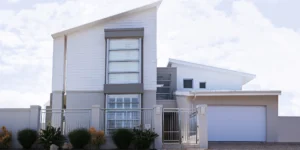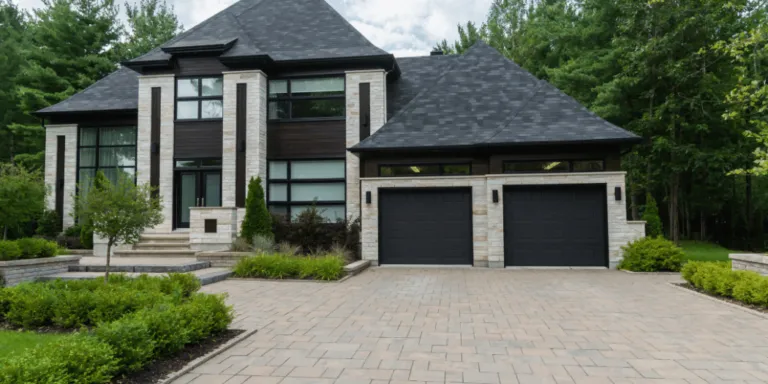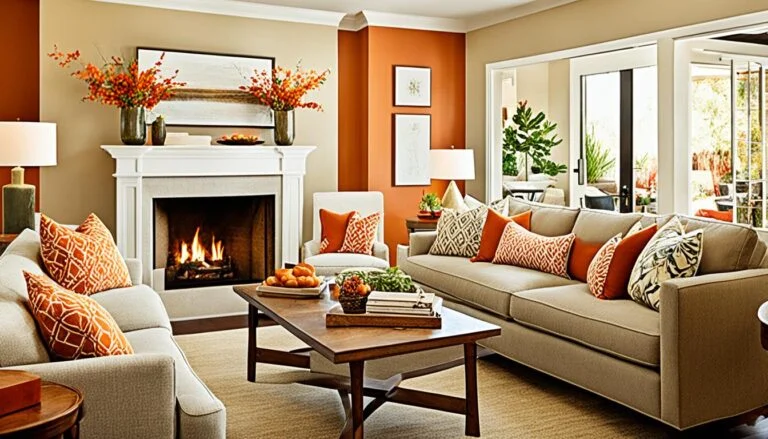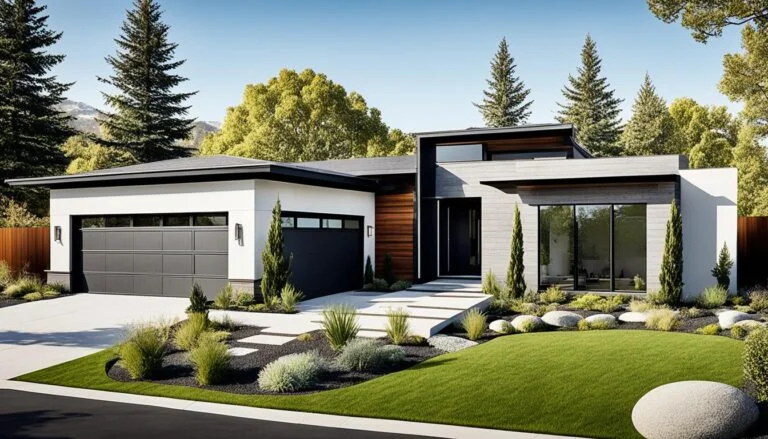Finding your perfect home is an exciting journey with many choices. There are so many home design types and architectural home styles to pick from. You might like the clean look of modern home designs, the classic beauty of traditional home designs, or the modern feel of contemporary home designs. Each style has its own charm and can show off your unique taste.
But looks aren’t everything. You should think about how a home uses energy, how it’s laid out, and how easy it is to keep up. Homes like rustic home designs offer a cozy feel, while coastal home designs bring in the fresh air. Farmhouse home designs are practical and beautiful. And for those who love simplicity, minimalist home designs are perfect.
Learning about all the different home designs helps you make a choice that fits your life, budget, and future plans. Whether it’s your first home or an investment, knowing about various styles makes the process easier. So, let’s start exploring the world of home design and find your dream house!
Key Takeaways:
- Understand the unique characteristics and benefits of various home design types
- Consider practical factors like energy efficiency, space utilization, and maintenance
- Familiarize yourself with a diverse array of architectural home styles
- Select a home design that aligns with your lifestyle, budget, and long-term goals
- Use home design software to visualize and plan your ideal home
Understanding Home Design Types and Styles
When designing your dream home, it’s key to know the different home design types and styles. From modern to traditional, each style has its own look and feel. Knowing these styles helps you pick what fits your taste and lifestyle.
The Difference Between Structure and Style
It’s important to know the difference between a home’s structure and style. The structure is the type of building, like a single-family home or apartment. The style is the look and design that make a home unique. For example, a single-family home can be in many styles, like craftsman or Mediterranean.
Using a floor plan creator can help with planning your home. This tool lets you try out different styles and layouts. It ensures your design fits your needs and tastes.
Factors That Influence Home Design Choices
Many things affect the style of your home, like your taste, lifestyle, where you live, and your budget. Some like the clean look of modern homes, while others prefer the cozy feel of traditional styles. Coastal designs might be good for oceanfront homes, and industrial styles for city living.
The table below shows some popular home design styles and what makes them unique:
| Design Style | Key Characteristics |
|---|---|
| Modern | Clean lines, smooth surfaces, minimal décor |
| Traditional | Dark wood furniture, luxurious textiles, classic elements |
| Contemporary | Sleek, simple, light-reflecting materials, ever-evolving |
| Rustic | Rough-hewn wood, exposed beams, textural fabrics |
| Minimalist | Clean lines, neutral colors, functional furniture, less is more |
| Coastal | Bright colors, whitewashed textures, summery materials |
| Farmhouse | Simple, functional, elements from Shaker and Colonial design |
| Industrial | Metal, rustic wood, leather, neutral color palettes |
| Mediterranean | Warm colors, terracotta tiles, wrought iron, arched doorways |
Finding your dream home starts with knowing what you like. By exploring different styles, you can find inspiration and make choices that reflect your taste and improve your life.
Contemporary Style Homes
Contemporary homes mix sleek lines, sustainable design, and open floor plans. They combine modern looks with practicality. These homes are perfect for today’s homeowners who want style and function.
Key Features of Contemporary Homes
Contemporary homes blend modern and traditional styles. They stand out with:
- Asymmetrical exteriors with strong geometric shapes
- Flat or low-pitched roofs
- Large windows and glass doors for ample natural light
- Open floor plans that create spacious, flowing interiors
- Eco-friendly materials such as wood, stone, and metal
- Minimalist decor that highlights the home’s architectural elements
These features make contemporary homes both beautiful and practical. They let homeowners show their style while enjoying modern living benefits.
Pros and Cons of Contemporary Style
Think about the good and bad of contemporary homes before deciding:
| Pros | Cons |
|---|---|
| Customizable to reflect personal tastes | Can be more expensive to build initially |
| Emphasis on sustainability and energy efficiency | Open floor plans may be challenging to heat or cool |
| Clean lines and minimalist layout for easy maintenance | Large windows may reduce privacy |
| Appeals to a wide range of buyers, ensuring resale value | May be difficult to blend with other architectural styles |
Choosing a contemporary home depends on your lifestyle, budget, and style likes. With their focus on sustainable design, open floor plans, and modern home aesthetics, contemporary homes are a great choice for those wanting style and function.
Ranch Style Homes
Ranch style homes have been a favorite in America for many years. They mix comfort, functionality, and beauty perfectly. These homes are single-story and have big layouts, open floor plans, and blend well with outdoor areas. They started in the 1920s in California and symbolize family closeness and suburban dreams.
Ranch homes are known for being single-story, making them easy to get around in and maintain. They have open floor plans that feel spacious and flow well. This makes them great for everyday living and having guests over.
Ranch homes have unique features that add to their charm and usefulness. These include:
- Large windows that let in lots of natural light
- Long, shallow roofs that give a low profile
- Deep eaves for shade and protection
- Attached garages or basements for extra space
- Outdoor areas like patios or big front porches that connect to inside
After World War II, ranch homes became very popular. They were perfect for veterans wanting a place to start a family. Architects like Cliff May and John Lautner made these homes popular by designing them for modern families. They wanted homes that were comfortable, affordable, and easy to manage.
Today, ranch homes are still the top choice in many states. You can find different types of ranch homes, like the California ranch or the Split-Level Ranch. These homes still charm people with their classic look and practical design.
Ranch homes have many benefits, like being easy to take care of and affordable. They also have big living areas that are great for families. But, they might need a bigger lot and the big front windows can make you less private. Also, adding to or changing a ranch home can be costly.
Even with these points, ranch homes are still very popular. They offer cozy living spaces, smart design, and a link to the outdoors. As design trends change, ranch homes are coming back into style. They remind us of the value of simple, functional living and chasing the American dream.
Classical Style Home Design Types
Stepping into a classical style house is like going back in time. These homes are filled with elegance and refinement. They have been loved by homeowners for centuries. The style includes Georgian, Federal, and Neoclassical, each with its own look.
Defining Characteristics of Classical Homes
Classical homes stand out with their symmetrical facades. They often have paladin windows or tripartite windows. Paladin windows have arched tops and divided panes. Tripartite windows have a central window with two smaller ones on each side. These windows let in lots of natural light and add beauty.
Another key feature is the central hall layout. You enter a grand foyer that leads to different rooms. This layout feels symmetrical and spacious, with high ceilings and wide doorways. The staircase is often stunning, showing off the skill of old times.
Advantages and Disadvantages of Classical Style
Living in a classical home has its pros and cons. These homes are built to last with quality materials. They show off luxury and sophistication with their detailed craftsmanship.
But, these homes need regular upkeep to keep looking great. Fixing and updating them can be expensive. Finding skilled workers to match the original craftsmanship is hard. Also, their formal layout might not fit every lifestyle, especially if you like a casual vibe.
| Architectural Movement | Time Period | Key Features |
|---|---|---|
| Georgian | 1714-1830 | Symmetrical facade, paladin windows, central hall layout |
| Federal | Late 18th to early 19th century | Delicate ornamentation, fanlights over front door, oval rooms |
| Neoclassical | Mid-18th to early 19th century | Columned porticos, pediments, elaborate moldings |
Despite the challenges, classical style homes offer a special experience. They mix history, elegance, and beauty. For those who love the finer things and are up for the upkeep, these homes are a true gem.
Cottage Style Homes
Cottage style houses are full of charm and comfort. They make you feel right at home with their warm atmosphere. These homes come in styles like cozy bungalows and enchanting Tudor houses, each with its own charm.
One key feature of cottage style homes is their open floor plans. These plans make the space feel bigger and flow better, even in smaller homes. Hallways and doorways are placed to use space well and improve the home’s function.
Cottage style houses are usually one to one-and-a-half stories tall. They have asymmetrical exteriors that add to their charm. This size makes them more affordable and easier to maintain. Decorating them is also budget-friendly since you need fewer items to make a stylish look.
| Cottage Style | Key Characteristics |
|---|---|
| Coastal (Cape Cod/American) | One to one-and-a-half stories |
| English | Gable or thatched roofs, sprawling gardens, stone walls |
| French | Long, narrow layout, long front porch, sloped gable roof |
| Nordic | Bright red exteriors, minimalistic style |
Smaller cottage style homes have many benefits but also some drawbacks. They can be hard to expand or renovate, especially if they’re historic. Cottages in remote areas might face more maintenance issues from wildlife or extreme weather.
Despite these challenges, the benefits of owning a cottage style home are many. These homes sell for an average of $236,000 in the U.S. Building one costs about $260,000 on average. The cost to build can range from $175,000 to $350,000, depending on location, materials, and size.
For those thinking of building their dream cottage, knowing the costs is important. Here are some average costs for different sizes:
- 600 sq. ft.: $75,000 – $150,000
- 800 sq. ft.: $100,000 – $200,000
- 1,000 sq. ft.: $125,000 – $250,000
- 1,500 sq. ft.: $187,500 – $375,000
- 2,000 sq. ft.: $250,000 – $500,000
Choosing a cozy bungalow, a charming Tudor house, or another cottage style means your home will be full of character and warmth. With their open layouts and inviting feel, cottage style homes are perfect for those wanting a cozy haven.
Farmhouse Style Homes
Farmhouse style homes are back in style, winning hearts with their mix of old-time charm and modern comfort. They bring a cozy feel, reminding us of traditional farmhouses. These homes are perfect for those who want a warm and welcoming place to live.
Essential Elements of Farmhouse Style
Farmhouse style homes stand out with their key features. They often have:
- Open concept living spaces that make everyone feel close and move easily
- Big front porches that welcome you in and are great for relaxing outside
- Kitchens with a traditional look but modern functions, like big islands and old-style sinks
- Use of natural materials like wood, stone, and metal for a real, rustic feel
- Color schemes that are soft and calm, making the space feel cozy
There are different farmhouse styles, each with its own twist:
| Farmhouse Sub-Style | Key Characteristics |
|---|---|
| Industrial Farmhouse | Inspired by farm machinery, it has a more masculine look |
| Coastal Farmhouse | Combines beach vibes with modern farmhouse touches |
| Scandinavian Farmhouse | Focuses on simplicity, light, and clean design with a mix of modern and rustic |
| Modern Farmhouse | Features sleek, modern design with contemporary touches like concrete floors and new lighting |
| Rustic Farmhouse | Includes handmade details, open shelves for vintage decor, and industrial materials |
| French or Country Farmhouse | Uses marble, warm wood floors, and antique pieces for a classic look |
| Colonial or Traditional Farmhouse | Includes real historical details like stone and colonial windows for a traditional feel |
Benefits and Drawbacks of Farmhouse Living
Farmhouse style homes have many pluses:
- They offer a cozy, welcoming vibe that makes you feel at home
- They’re flexible in letting you add your personal touch while keeping the farmhouse look
- Open living areas that are great for spending time with family and hosting guests
- Big front porches that add outdoor living space and look nice from the street
But, there are some downsides:
- Older farmhouse homes might need a lot of work to be up to today’s standards
- Keeping a farmhouse looking rustic and charming can take a lot of effort and money
- Farmhouse homes are often in rural areas, which might not be ideal for those who like city life
Despite these issues, farmhouse style homes still charm many people. They offer a unique mix of old-world charm and modern living. With careful design and a focus on warmth, a farmhouse home can be a special place to live.
Pueblo Revival Style Homes
Start a journey to the Southwest, where the Pueblo Revival style shines. This style takes cues from Native American pueblos and Spanish missions. It’s known for its wooden beams, desert colors, and flat roofs with a special trim.
In the 1920s and 1930s, this style became very popular in New Mexico and Arizona. The University of New Mexico in Albuquerque was an early fan, showing off buildings that define this style. Santa Fe helped make it famous, even making rules for its use in new buildings.
Pueblo Revival homes show off Native American architecture’s creativity. They use materials like adobe and wood, blending with the landscape. Features like big wooden beams and heavy doors add a rustic feel. Courtyards or patios connect indoor and outdoor living.
| Characteristic | Description |
|---|---|
| Vigas | Exposed wooden roof beams that protrude from the exterior walls |
| Parapet-trimmed Flat Roofs | Flat roofs with parapets that provide a distinctive silhouette |
| Earthy Materials | Use of adobe, concrete, stucco, or mortar for a natural look |
| Enclosed Courtyards | Patios or courtyards that integrate indoor and outdoor living |
The thick walls of these homes look great and keep the heat out. But, the flat roofs can leak, especially in older buildings. Still, the style is still loved, with new takes on it in homes and buildings across the Southwest.
The La Fonda Hotel in Santa Fe and homes on Canyon Road show the style’s lasting impact. It’s a mix of Native American culture and practical design. This makes homes that fit the Southwest’s climate and way of life perfectly.
Townhouse Style Homes
Townhouse style homes, also known as townhomes, are a top pick for those wanting the best of city life and private living. These homes stack up, sharing walls with neighbors but having their own entrance. They’re perfect for city dwellers needing space but don’t want the high cost of single-family homes.
Townhouse Features and Layouts
Townhouses stand out with their vertical design. They use space wisely by going up instead of out. This makes them great for crowded areas, offering lots of room inside. They usually have two to three stories, with each level for living, working, or sleeping.
Each townhouse has its own entrance, unlike apartments or condos. This adds to the privacy and feeling of owning your own home. It also makes the outside look of townhouse rows special, with each one showing off its own style.
Pros and Cons of Townhouse Living
Townhouses have their good points and downsides. They’re often cheaper than single-family homes in the same area. They cost less to build and maintain, making them great for first-time buyers or those wanting to downsize. Plus, the outside upkeep is often taken care of by an HOA.
But, townhouse living isn’t perfect. They usually have less outdoor space than single-family homes. This might be a problem for those who love gardening or need a big area for parties. Finding parking can also be tough, and the close living can sometimes mean more noise and less privacy. Yet, new building methods and soundproofing have lessened these issues.
| Pros | Cons |
|---|---|
| More affordable than single-family homes | Limited outdoor space |
| Lower maintenance responsibilities | Potential parking challenges |
| Vertical living optimizes space | Reduced privacy due to shared walls |
| Separate entrances enhance privacy | Noise issues from close proximity to neighbors |
Despite some downsides, townhouses are still a favorite. They offer city living, style, and a good price. When thinking about buying a home, consider your lifestyle, budget, and goals to see if a townhouse style house is right for you.
Mediterranean Style Homes
Dive into the magic of Mediterranean style houses. They mix the beauty of Spanish villas and Italian villas for a unique living experience. These homes are perfect for warm places like California and Florida. They offer a perfect mix of indoor-outdoor living, letting you enjoy the outdoors.
Mediterranean homes stand out with their tiled roofs and stucco walls. They also feature a mix of warm stone, wood, and metal on balconies and windows. Arched windows and doors, along with wrought iron and beautiful tile work, make them look like they’re right by the Mediterranean Sea.
Inside, Mediterranean homes are light and airy, full of natural light and air. They use organic materials, rich colors, and different tiles to create a rich experience. Imagine being surrounded by warm colors like terra cotta and burnt umber, with bright colors that match the Mediterranean scenery.
| Architectural Element | Characteristic |
|---|---|
| Tiled Roofs | Distinctive red or terracotta tiles |
| Stucco Walls | Smooth, white exterior finish |
| Arched Windows and Doors | Graceful curves and soft lines |
| Wrought Iron Accents | Decorative balconies and window grilles |
| Tile Ornamentation | Intricate patterns and vibrant colors |
The Mediterranean design has a long history, coming from the area around the Mediterranean Sea. Countries like Greece, Malta, Morocco, and Monaco have influenced it. This style became popular in the 1920s, a time of luxury and fun.
To decorate your Mediterranean-style house, focus on symmetry and use dark wood and walnut furniture. Choose light fabrics like linen and add color with tiles. Use a consistent color scheme and flooring for a unified look. Don’t forget to decorate your outdoor spaces with fire pits or canopies for a cozy feel.
Let the Mediterranean style bring warmth and beauty into your home. Its timeless charm will make your living space feel like a relaxing getaway.
Victorian Style Homes
Step back in time and dive into the grandeur of Victorian style houses, named after Queen Victoria. These homes, from the 19th century UK, mix luxury, detailed designs, and history. They still charm homeowners and fans today.
Recognizing Victorian Architecture
Victorian homes stand out with their steep gable roofs, bay windows, and towers. They often have turrets, dormers, chimneys, and stained glass. The outside is bright with colors and decorative trim. Their design is often not symmetrical, showing in both looks and layout.
During the Victorian era, many styles appeared, each with its own look:
- Gothic Revival (1840-1880): Inspired by medieval castles and cathedrals
- Italianate (1850-1890): Influenced by northern Italian villas
- Second Empire (1855-1885): Popular in large cities in the Northeast and Midwest
- Stick Style (1860-1890): A High Victorian elaboration of the Gothic Revival style
- Queen Anne (1880-1910): Dominated Victorian residential architecture
Advantages and Challenges of Victorian Homes
Living in a Victorian home is special, with its historical charm and unique features. You’ll find high ceilings, hardwood floors, and elegant staircases. The fireplaces, molding, and wainscoting add to the timeless beauty.
But, Victorian homes have their challenges. They often have small rooms and limited storage. The foundations and finishes need special care and can be costly to fix. Updating these homes while keeping their history can be tricky.
| Victorian Style | Years of Popularity |
|---|---|
| Gothic Revival | 1840-1880 |
| Italianate | 1850-1890 |
| Second Empire | 1855-1885 |
| Stick Style | 1860-1890 |
| Queen Anne | 1880-1910 |
Despite the challenges, Victorian style homes still win hearts. Their steep roofs, bay windows, and bright colors mix history, skill, and timeless beauty. They continue to enchant those who love history and elegance.
Home Design Types: Finding Your Perfect Match
Choosing the right home design is all about looking at your lifestyle, likes, and needs. It doesn’t matter if you’re a growing family, an empty nester, or a young professional. Your home should show off your personality and fit your daily life. Finding the right balance between looks and practicality is key to making a space feel like home.
Evaluating Your Lifestyle and Preferences
Before jumping into home decor trends and interior design styles, think about your lifestyle and what you like. Consider things like:
- Family size and future growth
- How often you’ll entertain guests
- How much privacy you need
- How much upkeep you’re okay with
- Your feelings about outdoor living spaces
Knowing what you want and how you’ll use your space helps you pick the right home design.
Balancing Aesthetics and Functionality
When looking at home decor and remodeling ideas, aim for a mix of looks and practicality. It’s easy to get caught up in the latest trends, but your home should be both beautiful and useful. Think about these points when choosing your design:
| Aesthetic Considerations | Functional Considerations |
|---|---|
| Architectural style and details | Floor plan and layout |
| Color palette and textures | Storage and organization solutions |
| Lighting and ambiance | Energy efficiency and sustainability |
| Furniture and decor selections | Accessibility and mobility needs |
By balancing looks and practicality, you can make a home that’s both beautiful and improves your life.
Working with skilled custom home builders and interior designers is a big help in designing and building your dream home. They can guide you on home decor trends, help pick materials that fit your style, and ensure your home is top quality.
Finding your perfect home design is a journey of self-discovery and exploration. Enjoy the process, trust your gut, and don’t hesitate to think differently. With careful thought and attention to detail, you can create a luxury home that mirrors your unique personality and lifestyle, offering comfort and inspiration for many years.
Conclusion
Looking into the many home design types and styles can be exciting when you’re searching for your dream home. You’ll find everything from modern homes with sleek lines to cozy farmhouses with rustic charm. Each style has its own look, benefits, and things to consider.
Think about your daily life, your family, and what you like in design. Do you want open spaces with lots of light or cozy areas with traditional touches? Or maybe you’re into Scandinavian minimalism or the mix of Bohemian style? Knowing what you need and want helps you pick the right style for you.
Your home should show who you are and be a place of comfort and happiness. Whether it’s a classic ranch, a cute cottage, or a modern townhouse, aim for a balance of looks and practicality. Work with experts to help you choose house plans and exterior designs. With thought and care, you can make a space that goes beyond your dreams and feels like home.
Starting this journey, keep an open mind and be open to new ideas. Try out different floor plans, materials, and finishes. Feel free to combine styles to make your space unique. Putting in the time and effort to find the right design will give you a home that’s beautiful, useful, and eco-friendly. You and your family will love it for many years.














